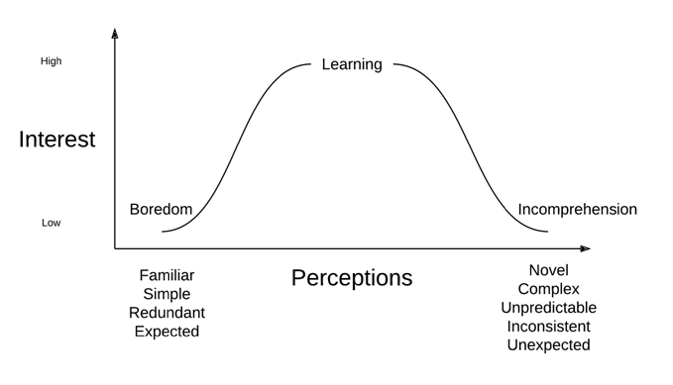The emerging sophistication of digital media and the accompanying sophistication of media skills are captured in the observation of Seels, Fullerton, Berry, and Horn (2004) that interest in and attention to media is characterized by a bell-shaped curve. Media that are familiar, simple, redundant, and expected are associated with low interest and attention because they are perceived as boring. Media that are too novel, complex, inconsistent, unpredictable, and surprising are associated with low interest and attention because they are perceived as incomprehensible. Between these extremes of low interest, there is a level of novelty and complexity that creates a high level of interest and attention (see figure 2.4). The authors argue that as users of media gain experience, more complex and novel media are required to hold their attention, so the location of the curve is moved to the right. As all users (including young people) gain experience with technology and complex ideas, learners will demand new and more complex ideas and media in classrooms at a rate greater than expected by populations in previous generations.

Figure 2.4. Interest in media versus users’ perceptions (adapted from Seels, Fullerton, Berry, and Horn 2004)
In the 21st century, information technology is defining the environment in which humans live and thus influencing how human brains develop. While this is not a new phenomenon, the current generations are experiencing one dominant information technology (print) being replaced another (ICT). The effects of technology on brains are exacerbated by the rapid diffusion of new ICT and because ICT is becoming an increasingly social medium. Because humans are fundamentally social and technology-using creatures, this transition is affecting deeply important aspects of our nature, and educators must accommodate these aspects of human nature in curriculum and instruction.
Reference
Seels, Barbara, Karen Fullerton, Louis Berry, and Laura Horn. 2004. “Research on Learning from Television.” In Handbook of Research on Educational Communications and Technology 2nd ed., edited by David Jonassen, 249-334. Mahwah, NJ: Lawrence Erlbaum Associates, Publishers.